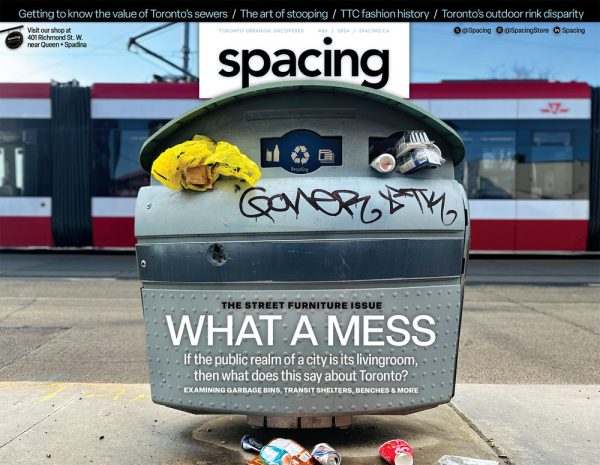The imminent end of the 20-year contract with Astral Media to supply and manage Toronto’s street furniture is a foreseeable follow-up to Spacing’s 20th anniversary. The development of the contract began just a few years after we were founded, and it was one of the issues we were most active about in those early years. It sat right at the heart of our mandate to discuss the public spaces of Toronto, and fit into our continuing interest in design.
While we’ve had many magazine and online features about street furniture, though, we never dedicated an issue to it. Now that the end of the contract is in sight, it’s time to start a conversation about where to go next. So we’ve taken the opportunity to put it on our cover and reflect on the two decades of the contract and what could be next.
The street furniture contract was one of few places we parted ways with David Miller as mayor. We has problems with the principle of outsourcing a civic responsibility to a third party, the reliance on advertising, and the uninspiring (and, it turned out, sometimes dysfunctional) design. As John Lorinc points out in his history of the contract, trying to manage the city’s furniture with constant reference to a private-sector third party is inherently clumsy and unsatisfactory.
To be fair, some elements worked out. The city has a lot more street furniture, it’s reasonably consistent, it’s mostly not terrible and often an improvement on the crappy excuses for furniture that featured before (remember those suburban plastic benches with a big ad on the backrest?). The garbage bins have been bad both aesthetically and functionally, but part of the problem has also been maintenance – they’re just not emptied often enough in high-traffic locations. (Ironically, the same week this issue arrived in our store, the City announced new, slightly improved garbage bins. But we still hope for a complete rethinking in the next round.)
The impetus and funds from the contract also enabled the city to set up a unit dedicated to managing the public realm, which it had never had before. This innovation recognized one of the key reasons we founded Spacing: the public realm is vital to the health of a city, and needs to be taken care of consciously and directly. The unit developed principles, for example, about how to manage sidewalks so that they were free of obstructions but provided amenities, functionality, and vibrancy through street furniture, utility boxes, and patios.
The unit has since disappeared in a reorganization, its functions shared out among new sections. But if Toronto wants to finally take full responsibility for street furniture and bring its design and management in-house, it will need to build capacity, and that will mean a dedicated, focused team of staff. It cannot be a responsibility shared between other units for whom it’s always a secondary concern, or we will continue with the mediocre and half-hearted process we’ve experienced through a private-public contract. The public realm is where the city comes together – it needs its champions in-house as well as outside.
The issues that come through when talking about street furniture also apply to the other shared infrastructure that underpins the city. In our front section, Nathan Abraha shows how Toronto Water plans ahead for the future to keep our water systems maintained – perhaps a model for how a civic street furniture program could function. The map of outdoor skating rinks by Jeff Alan and Teresa Lau reminds us that the inequalities present in the pre-amalgamation cities can persist to this day, 25 years later. Evening out those inequalities was one of the goals of the street furniture program – one that was partially successful, but still needs to be a focus for the next two decades. A mini-feature of two articles about accessibility highlights the need for amenities that make our sidewalks welcoming for everyone.
And in the end, that’s the purpose of street furniture – to encourage people to use our public spaces. Teru Ikeda talks to some of the denizens who bring life to the somewhat sterile expanse of the soon-to-be-renamed square at the corner of Yonge and Dundas. Drew-Anne Glennie explores how putting out goods for re-use makes our sidewalks into spaces for free exchange. And Natalie Welsh brings to life the former TTC Guides, who used to animate our transit system in their trim uniforms, providing assistance to anyone who needed it. Street furniture is important, but it’s the people who use it who make our public spaces thrive.
This issue is available at the Spacing Store at 401 Richmond St. W., and at fine book and magazine stores shortly, as well as arriving soon in subscribers’ mailboxes.


